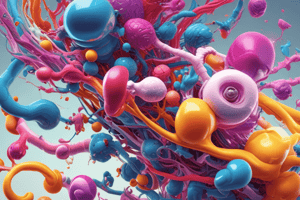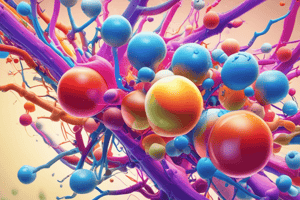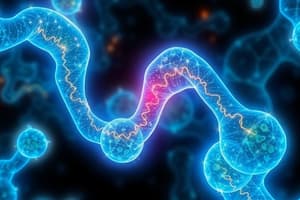Podcast
Questions and Answers
Fatty acids and amino acids such as ______ can serve as alternate fuels.
Fatty acids and amino acids such as ______ can serve as alternate fuels.
glutamine
In the process of energy production, ______ is converted into Acetyl CoA.
In the process of energy production, ______ is converted into Acetyl CoA.
pyruvate
The ______ Cycle, also known as the Kreb's Cycle, plays a critical role in energy production.
The ______ Cycle, also known as the Kreb's Cycle, plays a critical role in energy production.
Citric Acid
Mitochondrial DNA depletion syndrome (MDDS) leads to a drop in mitochondrial ______.
Mitochondrial DNA depletion syndrome (MDDS) leads to a drop in mitochondrial ______.
Energy production is central to ______.
Energy production is central to ______.
Catabolic metabolism is primarily associated with ______ down complex molecules.
Catabolic metabolism is primarily associated with ______ down complex molecules.
An example of a catabolic process is ______ acid oxidation.
An example of a catabolic process is ______ acid oxidation.
The process of cellular respiration that requires oxygen is called ______ respiration.
The process of cellular respiration that requires oxygen is called ______ respiration.
ATP stands for adenosine ______ phosphate.
ATP stands for adenosine ______ phosphate.
The mitochondrial ______ is where pyruvate oxidation and the citric acid cycle occur.
The mitochondrial ______ is where pyruvate oxidation and the citric acid cycle occur.
During respiration, the main electron carriers are NADH and ______.
During respiration, the main electron carriers are NADH and ______.
One glucose molecule can yield over ______ ATP molecules through complete oxidation.
One glucose molecule can yield over ______ ATP molecules through complete oxidation.
The main purpose of the electron transport chain is to produce ______.
The main purpose of the electron transport chain is to produce ______.
Chemiosmotic coupling links ATP synthesis with ______ transport.
Chemiosmotic coupling links ATP synthesis with ______ transport.
Mitochondria are sometimes referred to as the ______ of the cell due to their role in energy production.
Mitochondria are sometimes referred to as the ______ of the cell due to their role in energy production.
Fatty acids and ______ serve as alternate fuels in metabolism.
Fatty acids and ______ serve as alternate fuels in metabolism.
In the mitochondria, ______ is produced through oxidative phosphorylation.
In the mitochondria, ______ is produced through oxidative phosphorylation.
Mitochondrial DNA depletion syndrome results in a drop in mitochondrial ______.
Mitochondrial DNA depletion syndrome results in a drop in mitochondrial ______.
The citric acid cycle is also referred to as the ______ Cycle.
The citric acid cycle is also referred to as the ______ Cycle.
The conversion of pyruvate into Acetyl CoA occurs in the ______.
The conversion of pyruvate into Acetyl CoA occurs in the ______.
Catabolic metabolism is characterized by ______.
Catabolic metabolism is characterized by ______.
The process of energy extraction in cells is known as ______ respiration.
The process of energy extraction in cells is known as ______ respiration.
The primary energy carrier in biological systems is ______.
The primary energy carrier in biological systems is ______.
Oxidative phosphorylation occurs in the ______ membrane of mitochondria.
Oxidative phosphorylation occurs in the ______ membrane of mitochondria.
Mitochondria are vital for ______ production in cells.
Mitochondria are vital for ______ production in cells.
Glycolysis converts glucose into two molecules of ______.
Glycolysis converts glucose into two molecules of ______.
The breakdown of fatty acids takes place in the ______.
The breakdown of fatty acids takes place in the ______.
The production of reactive oxygen species (ROS) occurs in the ______.
The production of reactive oxygen species (ROS) occurs in the ______.
ATP synthase is responsible for converting ADP and inorganic phosphate into ______.
ATP synthase is responsible for converting ADP and inorganic phosphate into ______.
What condition is characterized by lactic acidosis and a deficiency in the pyruvate dehydrogenase enzyme?
What condition is characterized by lactic acidosis and a deficiency in the pyruvate dehydrogenase enzyme?
Which of the following molecules is produced during the TCA cycle as a precursor for energy production?
Which of the following molecules is produced during the TCA cycle as a precursor for energy production?
Which process occurs in the mitochondria and requires oxygen to convert nutrients into ATP?
Which process occurs in the mitochondria and requires oxygen to convert nutrients into ATP?
Which of the following is NOT a characteristic of mitochondrial DNA depletion syndrome (MDDS)?
Which of the following is NOT a characteristic of mitochondrial DNA depletion syndrome (MDDS)?
What role do free fatty acids play in cellular metabolism?
What role do free fatty acids play in cellular metabolism?
What is the primary difference between catabolic and anabolic metabolism?
What is the primary difference between catabolic and anabolic metabolism?
Which process is primarily responsible for the majority of energy extraction in cells?
Which process is primarily responsible for the majority of energy extraction in cells?
In the mitochondria, what is the function of the inner membrane?
In the mitochondria, what is the function of the inner membrane?
What is produced during the TCA cycle from one molecule of Acetyl CoA?
What is produced during the TCA cycle from one molecule of Acetyl CoA?
Which statement describes the role of chemiosmotic coupling in mitochondria?
Which statement describes the role of chemiosmotic coupling in mitochondria?
What is not a key function of mitochondria?
What is not a key function of mitochondria?
How many NADH molecules are produced from one glucose molecule through glycolysis and subsequent reactions?
How many NADH molecules are produced from one glucose molecule through glycolysis and subsequent reactions?
In which location within mitochondria does pyruvate oxidation take place?
In which location within mitochondria does pyruvate oxidation take place?
What is the end result of the entire aerobic respiration process?
What is the end result of the entire aerobic respiration process?
What role does ATP synthase play in the mitochondria?
What role does ATP synthase play in the mitochondria?
What is a primary consequence of mitochondrial DNA depletion syndrome (MDDS)?
What is a primary consequence of mitochondrial DNA depletion syndrome (MDDS)?
Which molecule acts as a substrate for ATP production during oxidative phosphorylation?
Which molecule acts as a substrate for ATP production during oxidative phosphorylation?
Which metabolic process occurs in the mitochondria and involves multiple substrates, including fatty acids?
Which metabolic process occurs in the mitochondria and involves multiple substrates, including fatty acids?
Which statement accurately describes the role of free fatty acids in metabolism?
Which statement accurately describes the role of free fatty acids in metabolism?
Lactic acidosis can arise from deficiencies in which key enzyme?
Lactic acidosis can arise from deficiencies in which key enzyme?
Which statement best describes the primary function of the electron transport chain in mitochondria?
Which statement best describes the primary function of the electron transport chain in mitochondria?
What is primarily produced during the Citric Acid Cycle from a single Acetyl CoA molecule?
What is primarily produced during the Citric Acid Cycle from a single Acetyl CoA molecule?
Which of the following components of mitochondria is specifically involved in the synthesis of ATP?
Which of the following components of mitochondria is specifically involved in the synthesis of ATP?
What is the main result of glycolysis in the context of cellular respiration?
What is the main result of glycolysis in the context of cellular respiration?
In which specific mitochondrial structure does pyruvate oxidation take place?
In which specific mitochondrial structure does pyruvate oxidation take place?
What is the key relationship described by chemiosmotic coupling in the context of ATP production?
What is the key relationship described by chemiosmotic coupling in the context of ATP production?
Which of the following best describes the process of oxidative phosphorylation?
Which of the following best describes the process of oxidative phosphorylation?
Which of the following is NOT a function of mitochondria?
Which of the following is NOT a function of mitochondria?
What is the significance of the redox potential in energy production?
What is the significance of the redox potential in energy production?
How many ATP molecules can be generated from one glucose molecule through the entire aerobic respiration process?
How many ATP molecules can be generated from one glucose molecule through the entire aerobic respiration process?
What condition is characterized by a drop in mitochondrial DNA and lactic acidosis?
What condition is characterized by a drop in mitochondrial DNA and lactic acidosis?
Which of the following roles does the citric acid cycle NOT take part in?
Which of the following roles does the citric acid cycle NOT take part in?
Which of the following statements best describes fatty acids in metabolism?
Which of the following statements best describes fatty acids in metabolism?
What is the primary consequence of pyruvate dehydrogenase deficiency?
What is the primary consequence of pyruvate dehydrogenase deficiency?
What is the role of ATP synthase in the mitochondria?
What is the role of ATP synthase in the mitochondria?
What is the primary function of mitochondria in cells?
What is the primary function of mitochondria in cells?
What process occurs in the inner membrane of the mitochondria?
What process occurs in the inner membrane of the mitochondria?
Which component of mitochondria is responsible for electron transport?
Which component of mitochondria is responsible for electron transport?
What type of metabolism involves the building up of complex molecules?
What type of metabolism involves the building up of complex molecules?
What is produced from one glucose molecule during glycolysis?
What is produced from one glucose molecule during glycolysis?
During the citric acid cycle, what is generated from each Acetyl CoA?
During the citric acid cycle, what is generated from each Acetyl CoA?
Which of the following statements is true regarding the chemiosmotic process?
Which of the following statements is true regarding the chemiosmotic process?
In the context of mitochondrial functions, buffering redox potential takes place in which location?
In the context of mitochondrial functions, buffering redox potential takes place in which location?
What is the main purpose of the electron transport chain in mitochondria?
What is the main purpose of the electron transport chain in mitochondria?
What results from the complete oxidation of one glucose molecule?
What results from the complete oxidation of one glucose molecule?
Flashcards
Alternate fuels
Alternate fuels
A group of molecules that can be used as an energy source in the body, alternatives to glucose.
Fatty acids
Fatty acids
A type of alternate fuel derived from fats, used to generate energy.
Amino acids
Amino acids
A type of alternate fuel derived from proteins, used to generate energy.
Mitochondrial DNA depletion syndrome (MDDS)
Mitochondrial DNA depletion syndrome (MDDS)
Signup and view all the flashcards
Pyruvate dehydrogenase deficiency
Pyruvate dehydrogenase deficiency
Signup and view all the flashcards
Catabolism
Catabolism
Signup and view all the flashcards
Anabolism
Anabolism
Signup and view all the flashcards
Aerobic respiration
Aerobic respiration
Signup and view all the flashcards
ATP
ATP
Signup and view all the flashcards
Chemiosmotic coupling
Chemiosmotic coupling
Signup and view all the flashcards
Mitochondrion
Mitochondrion
Signup and view all the flashcards
Outer membrane (Mitochondria)
Outer membrane (Mitochondria)
Signup and view all the flashcards
Intermembrane space (Mitochondria)
Intermembrane space (Mitochondria)
Signup and view all the flashcards
Inner membrane (Mitochondria)
Inner membrane (Mitochondria)
Signup and view all the flashcards
Cristae (Mitochondria)
Cristae (Mitochondria)
Signup and view all the flashcards
Study Notes
Catabolic vs Anabolic Metabolism
- Catabolic metabolism breaks down molecules.
- Catabolism consumes more mass than it synthesizes.
- Examples include fatty acid oxidation.
- Anabolic metabolism builds up molecules.
- Anabolism consumes less mass than it synthesizes.
- Examples include fatty acid synthesis and protein translation.
- Catabolism and anabolism are balanced in homeostasis.
Energy Production
- Cells gain energy from oxidizing organic molecules.
- Energy is stored in chemical bonds within organic molecules.
- Cells release energy by gradually oxidizing molecules, and this is done via aerobic respiration.
- Two main energy-producing systems in cells are mitochondria and chloroplasts.
- Chemiosmotic coupling is a link between ATP production and membrane transport.
Biological Energy
- Energy is stored and transferred in cells using adenosine triphosphate (ATP).
Mitochondria Structure
- Mitochondria have an outer membrane (freely permeable due to presence of porin channel proteins), inner membrane (highly folded structure housing components of the ETC), and intermembrane space.
- The inner membrane has folds called cristae, and the innermost compartment is called the matrix (houses maternal DNA).
- Mitochondria contain their own DNA and manufacture some proteins.
- Key structures include porins and cristae.
Chemiosmotic Process
-
Stage 1: Electron transport drives proton pumps across the membrane.
-
Stage 2: The proton gradient drives ATP synthase to form ATP.
-
The electron transport chain is composed of multiple protein complexes which pass electrons from one complex to the next... order these protein complexes from the first (where electrons are released) to the last (where the terminal electron acceptor is located).
NADH dehydrogenase complex
Ubiquinone
Cytochrome B-C1 complex
Cytochrome C
Cytochrome oxidase complex
Mammalian Cell Respiration
- Bioenergetics is vital for cell survival, growth, and function.
- Biosynthesis is essential for cell growth.
- Signaling is necessary for cell functions.
The Mitochondrion
- The mitochondrion is responsible for energy production.
- Cells need mitochondria to produce energy from glucose.
- If no mitochondria are available, energy would come from anaerobic glycolysis.
- Glycolysis occurs in the cytosol.
- Glycolysis includes stages 1 and 1a of respiration.
Mitochondria - Key Structures
- Outer membrane (Phospholipid synthesis), Intermembrane space, Inner membrane (Oxidative phosphorylation and Citric acid cycle) , Cristae (ETC), and Matrix (Pyruvate oxidation, buffering redox potential).
- The roles of these structures in cellular respiration vary.
Redox Potential
- Electron transfer processes supply the majority of cellular energy.
- NADH is an important electron carrier, undergoing a redox reaction.
Stages of Respiration
- Stage 1A: Glycolysis is the initial breakdown of glucose in the cytosol.
- Stage 1B: Pyruvate oxidation converts pyruvate into acetyl CoA in the mitochondria.
- Stage 2: The citric acid cycle (Krebs cycle) oxidizes acetyl CoA.
- Stage 3: The electron transport chain (ETC) transfers electrons in mitochondria.
- Stage 4: ATP synthase uses the proton gradient to create ATP.
Oxidative Phosphorylation
-
Glycolysis converts one glucose molecule into two acetyl CoA molecules, four NADH, and two ATP.
-
The citric acid cycle produces 3 NADH, 1 FADH2, and 1 ATP per each acetyl CoA molecule.
-
A total of 6 NADH, 2 FADH2, and 2 ATP are produced.
-
Oxidative phosphorylation produces more than 30 ATP molecules per glucose molecule.
-
During the citric acid cycle, acetyl-CoA is converted into various molecules... order these molecules from when acetyl-CoA enters the cycle
Acetyl-CoA
Citrate
α-Ketoglutarate
Succinate
Malate
Oxaloacetate
Alternate Fuels
- Fatty acids and amino acids (such as glutamine) can be used as alternate energy sources.
- Fatty acid oxidation occurs within the mitochondria.
Mitochondrial Disorders
- Disorders affecting mitochondria include mitochondrial DNA depletion syndrome (MDDS) and pyruvate dehydrogenase deficiency.
- These disorders result in lactic acidosis, due to deficient activity related to oxidative pathways.
Summary
- Energy production and metabolism in mitochondria are central to cells.
- Energy is produced via the conversion of food molecules into ATP.
- Food molecules enter the mitochondria from the cytosol.
Studying That Suits You
Use AI to generate personalized quizzes and flashcards to suit your learning preferences.




